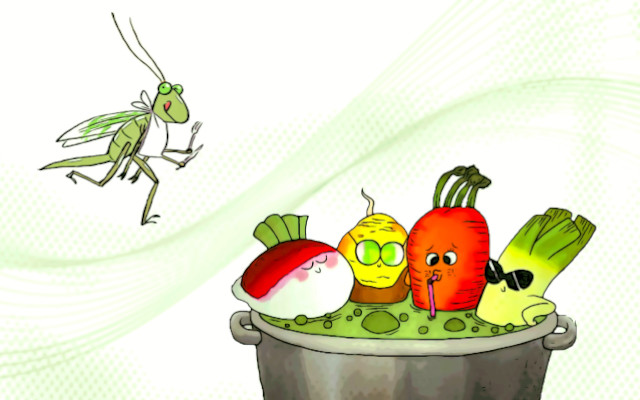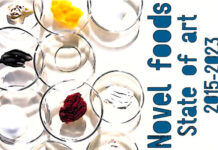The migratory locust receives the official green light as a novel food in the EU, under the conditions set out in reg. EU 2021/1975. (1) It is the second among authorized insects in the food chain, after flour moths.
Locust migration, EFSA’s scientific opinion.
EFSA(European Food Safety Authority), in its scientific opinion 25.5.21, evaluated the safety of Locusta migratoria as a novel food in frozen intact, dried intact and powdered forms. The data (e.g., composition, contaminants) and studies provided (e.g., toxicological) produced by the applicant, under the proposed conditions and levels of use, were considered suitable for assessing its safety with food destination. (2)
Particular attention was paid to the risk of allergic sensitization to proteins from this, as well as other novel foods. Scientific studies in this regard are still lacking, in some cases and ambiguous. Sensitization of individuals allergic to crustaceans, shellfish and dust mites appears possible, and carry-over of allergens contained in animal feed is likely, the use of which must therefore be considered in self-monitoring.
Migratory locust, authorized food uses
Reg. EU 2021/1975 authorizes the use of locust-in its three forms-frozen, dried, and powdered-as a snack and food ingredient in a range of products intended for the general population, excluding infants and young children (< 3 years). Next, foods where locusts can be included as ingredients, subject to the maximum use levels established for each category:
– processed potato-based vegetables, legume and pasta dishes, soups and concentrates, canned legumes and vegetables, salads, cocoa products, nuts, oilseeds and chickpeas,- meat products (sausages) and meat substitute proteins,
– Frozen fermented milk products,
– Beers and alcoholic beverage mixes.
Legal name and allergens
The legal name of the new food is ‘Frozen Locust Migratory,’ ‘Dried Locust Migratory Powder,’ or ‘Whole Locust Migratory Powder,’ depending on the form used.
The ability to cause allergic reactions in those with known reactions to crustaceans, shellfish, shellfish products, and dust mites must then be indicated alongside the list of ingredients. Instead, the Commission found it inappropriate to prescribe labeling the ability to cause primary sensitization.
Product Specifications
Product specifications-along with conditions of use and labeling requirements-will be included in the list of authorized novel foods. (3)

The novel food covers only adult specimens, which will have to have their wings and legs removed-in whole, frozen or dried form-since their consumption as such can cause constipation.
The powdered form, on the other hand, does not require the removal of wings and legs, as grinding is able to reduce their size to a level that does not cause problems.
Nutritional profiles, microbiological criteria, and contaminants
The composition sees moisture as the predominant element in the frozen form (67-73%), with lower shares of protein (11-21%) and fat (7-13%). In the other two forms, protein (43-60%) and fat (31-41%) contents stand out, with high dietary fiber content (<9%). Saturated fats express a significant proportion of total fat (35-43%).
Microbiological criteria and contaminant levels lack specific discipline for insects. EFSA therefore compared the reported values with those provided for other food categories. (4) Finding the absence of criticality, provided as a matter of course that good hygienic practices are followed starting from the farm and HACCP in the subsequent stages.
Authorization with exclusivity
Fair Insects BV (The Netherlands) filed the permit application, in this case as in that of the house cricket. (5) With a request, in both cases, for protection of the data presented in the dossier. Therefore, the European Commission granted exclusive marketing rights for food-grade locusts–to Fair Insects BV and its licensees–for 5 years from 5.12.21.
Transparency, to which even a special regulation has been dedicated (reg. EU 2019/1381. See footnote 6), is therefore compromised precisely in relation to the studies produced, which are considered suitable for the award of a five-year monopoly to the applicant. (7)
Interim conclusions
The plate of insects for food use is increased by only two species, which are exclusively authorized to the respective applicants. Almost four years of the entry into force of the new Novel Foods Regulation (reg. EU 2283/2015) and the Commission’s confirmation of its application to insects. (8)
The development of new , innovative and sustainablesources of protein, such as insects and microalgae, fulfills a global need for food security to which Europe can contribute through cutting-edge research.
Licensing exclusivities regardless of patent ownership on new molecules or production processes are a serious obstacle to the spread of novel foods and thus also to the achievement of the second among the Sustainable Development Goals.
#SDG2, End Hunger.
Dario Dongo and Andrea Adelmo Della Penna
Notes
(1) Reg. (EU) 2021/1975, authorizing the placing on the market of frozen, dried and powdered Locusta migratoria as a novel food under Regulation (EU) 2015/2283. http://data.europa.eu/eli/reg_impl/2021/1975/oj
(2) EFSA NDA Panel et al. (2021). Safety of frozen and dried formulations from migratory locust (Locusta migratoria) as a Novel food pursuant to Regulation (EU) 2015/2283. EFSA Journal 19(7):e00667, https://doi.org/10.2903/j.efsa.2021.6667
(3) Reg. EU 2017/2470, Annex
(4) Reg. EC 1881/06, reg. EC 2073/05
(5) Dario Dongo, Andrea Adelmo Della Penna. Crickets on the table, green light from EFSA. GIFT(Great Italian Food Trade). 18.8.21, https://www.greatitalianfoodtrade.it/progresso/grilli-a-tavola-via-libera-da-parte-di-efsa
(6) Regulation (EU) 2019/1381 on transparency and sustainability of Union risk analysis in the food chain. https://bit. ly/3DxkIie
(7) Other operators interested in marketing locusts as novel foods are then forced to apply for a permit from Fair Insects BV or submit (at their own expense) a new application, without even being able to refer to the studies and data already validated by EFSA
(8) Dario Dongo. Insects at the table in the EU. GIFT(Great Italian Food Trade), 9.2.18, https://www.greatitalianfoodtrade.it/idee/insetti-a-tavola-in-ue









